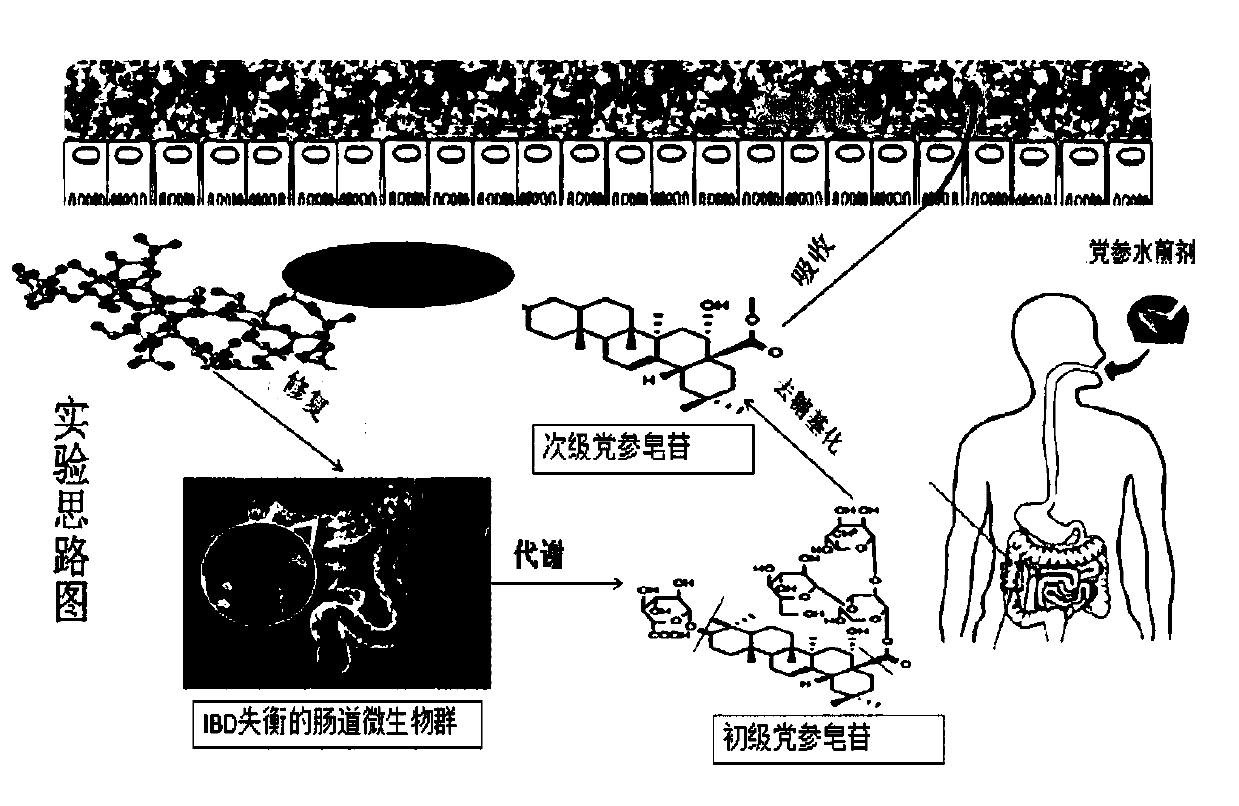Application of codonopsis pilosula polysaccharide as medicine for regulating intestinal flora of human body
A technology of Codonopsis polysaccharide and intestinal flora, applied in drug combination, food science, digestive system, etc., can solve the problems of difficult mutual mechanism and unclear interaction relationship.
- Summary
- Abstract
- Description
- Claims
- Application Information
AI Technical Summary
Problems solved by technology
Method used
Image
Examples
experiment example 1
[0043] Such as figure 1 It has been shown that the establishment of suitable animal models is the key to exploring the pathogenesis of diseases and evaluating the therapeutic effect of new clinical drugs. For IBD, establishing a mouse colitis model is the most commonly used method to explore its pathological mechanism. Common colitis models include: spontaneous, genetically modified, and induced colitis models. Among them, the acute mouse colitis model stimulated by the chemical substance dextran sodium sulfate (DSS) is currently the most widely used. Therefore, this chapter explores the experimental cycle of DSS modeling to prepare for later experiments. Material
[0044] Experimental animals: clean grade C57BL / 6 female mice (18 ± 2g; 4 weeks old) purchased from Hunan Slake Jingda Experimental Animal Co., Ltd.;
[0045] Instruments: NC-MS electronic balance, HMS-350 vortex oscillator, DH-500 constant temperature incubator, HS-202 paraffin slicer;
[0046] Reagent: DSS (m...
experiment example 2
[0065] Experimental Example 2 Study on the effect of drugs on intestinal flora and Th17 / Treg in mice with colitis
[0066] In recent years, with the idea that "multi-components of traditional Chinese medicine act on multiple targets at the same time", restoring the disordered intestinal flora and reshaping the Th17 / Treg balance has become a research hotspot as a new research target for the treatment of IBD . Because of its wide range of pharmacological effects and significant advantages in immune regulation, polysaccharides from traditional Chinese medicines can be degraded by intestinal flora through various mechanisms and then utilized by the body. Codonopsis Codonopsis is a classic traditional Chinese medicine for invigorating the middle and nourishing Qi. The effects of its representative active pharmacological molecule Codonopsis polysaccharide on the intestinal flora of IBD and the expression of cytokines related to Th17 / Treg balance have not yet been clarified. Based o...
experiment example 3
[0119] Effect of Experimental Example 3 Drugs on SCFAs Content and Related Bacteria in Colitis Mice
[0120] As a source of energy for colonic cells, SCFAs can exert anti-inflammatory and antibacterial effects by improving intestinal permeability and internal environment, regulating body energy homeostasis and immune cell chemotaxis. In order to explore whether Codonopsis polysaccharides will affect the changes of SCFAs-producing bacteria in the intestinal tract of colitis mice and the SCFAs content in feces after acting on acute colitis. The present invention detects the content of SCFAs in the feces of mice with acute colitis induced by DSS by gas chromatography (GC), and analyzes the changes of bacterial genera associated with the production of SCFAs in the intestinal tract of colitis mice in combination with the results of 16SrRNA sequencing.
[0121] Experimental Materials
[0122] Instrument: Agilent 7890B gas chromatograph (including FID detector); NC-MS electronic bal...
PUM
 Login to View More
Login to View More Abstract
Description
Claims
Application Information
 Login to View More
Login to View More - R&D
- Intellectual Property
- Life Sciences
- Materials
- Tech Scout
- Unparalleled Data Quality
- Higher Quality Content
- 60% Fewer Hallucinations
Browse by: Latest US Patents, China's latest patents, Technical Efficacy Thesaurus, Application Domain, Technology Topic, Popular Technical Reports.
© 2025 PatSnap. All rights reserved.Legal|Privacy policy|Modern Slavery Act Transparency Statement|Sitemap|About US| Contact US: help@patsnap.com



